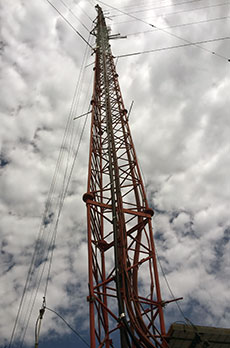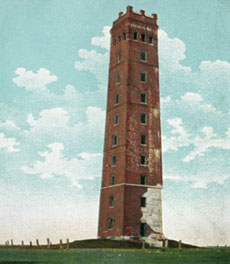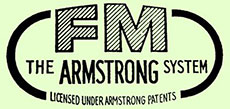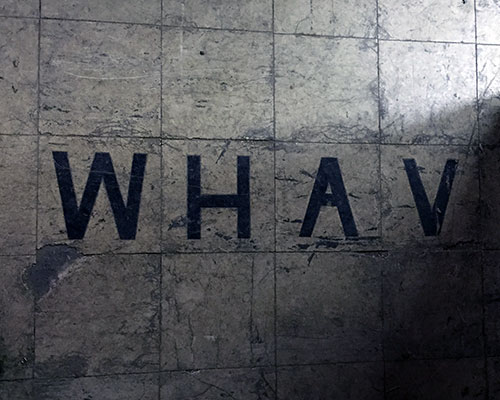Welcome home! During a Silver Hill site walk Friday, WHAV’s call letters were found still inscribed in the floor tiles placed 69 years ago.
After several years of engineering studies, legal challenges and other obstacles, the new WHAV 97.9 FM is finally going home.
“Home” is the original WHAV transmitter site atop Silver Hill where AM broadcasts began March 16, 1947 and FM about a year later. An initial engineering site walk Friday uncovered a welcoming piece of history—WHAV’s call letters still inscribed in floor tiles near an abandoned entrance.

Just $30,000 stands in the way of WHAV installing its new antenna on this tower at Silver Hill. You can give at https://www.gofundme.com/mjp130.
Engineer David J. Doherty of Skywaves Consulting, Millbury, and WHAV President and General Manager Tim Coco assessed the site and tower where WHAV’s new antenna will be erected. WHAV first proposed bringing a new FM station back to the site in a fall, 2013, application with the Federal Communications Commission (FCC). To settle a challenge from another applicant, it appeared for a time WHAV would have to erect a new tower in the eastern part of the city. After accruing still more engineering and legal fees, WHAV was finally awarded a modified construction permit for the Silver Hill site May 10, 2016.
Non-profit WHAV still requires at least $30,000 to complete purchase of minimal transmission equipment and have contractors install an antenna 350 feet above ground. Donations to WHAV’s “Make Waves” campaign, headed by honorary chairperson Tom Bergeron, are encouraged and gratefully accepted at GoFundMe.
Besides the WHAV name in floor tiles, few other obvious vestiges of WHAV’s long history remain inside the building, designed especially for the radio station by Washington Square architect Clinton F. Goodwin during the mid-1940s.
Silver Hill History

It took three tries and 200 pounds of dynamite to bring down Tilton Tower on Christmas, 1945.
Outside, the original WHAV tower still stands. Hoyt Construction Co., Portland, Maine, began assembly of the 248-foot tower during February, 1947.
The first 166 feet of the tower was designed for AM radio broadcasting, while an additional 80-foot mast was added for FM broadcasting and two feet more for a beacon light. The entire three-legged structure—each leg placed on a ceramic insulator—sits roughly where Tilton’s Tower once stood.
Shoe manufacturer John C. Tilton completed construction of the brick and granite tower, his second on the site, in 1887. Visitors could pay a small fee to climb to the top of the 125-foot observatory. Shortly after Tilton’s death in 1897, but before the property could be conveyed to the city, vandals destroyed the interior staircase. It languished for years.
Plans for an FM radio station, later to be known as WHAV, were first announced April 14, 1945. After the city declared the land surplus, which required permission from Tilton’s heirs who held reversionary rights, the Haverhill Gazette purchased it at auction for $1,925. On behalf of the Gazette, Attorney John J. Ryan Jr. placed the only bid in early October, 1945.
It took 200 pounds of dynamite to demolish Tilton’s tower during Christmas Eve and day, 1945. Edward Topping, Andover, was hired to take down the structure, but it resisted falling. After three tries, the observatory finally fell.
In its place, a 12-ton concrete base was poured near the end of 1946 for the radio tower.
Labor Disputes During 1946 and 1947 Delays Building Progress
Construction of the Silver Hill transmitter building began in 1946 under the direction of Haverhill contractor William H. Starbird. Initial construction, however, was slowed by a labor dispute. Starbird had been dubbed “unfair to organized labor” because he hired non-union workers.
In one example, steel was to be delivered to Silver Hill by the Haverhill-Lawrence Transportation Co. from the Boston branch of the Truscon Steel Co. However, the dispute forced the shipment to be dropped off behind the Gazette’s then-179 Merrimack St. printing plant. Truck drivers, members of the Teamsters and Chauffeurs local affiliated with AFL Central Labor Union, refused to deliver the ton and a half of steel all the way. Starbird’s workers reloaded the steel downtown and delivered it to Silver Hill.
Charles E. Tomes, union business agent, explained the radio station was placed on an unfair list. “Union workers know about the case and when they have materials to deliver, they refuse to deliver them,” he was quoted as saying then.
For his part, Starbird argued, “I don’t know what this union trouble is all about. We pay all workers union wages, and work on the union hourly schedule. I can’t make my men join the union of they don’t want to.” Workers reportedly objected to a $50 union initiation fee.
Meanwhile, concrete from Gilday and Morrison Co. (which later became Georgetown Construction Co.), Newburyport, was delivered, and Haverhill Wire Inspector Carl F. Smith issued a permit for electrical work Dec. 12, 1946. The authorization was issued over the objection of John Dillon, business agent for electrical workers. Raymond Heath of Heath Electric Co. was awarded the job after electricians Anthony Cebula and H.L. Kirkpatrick turned down the work because of union pressure. Merrimac Drilling Co. was responsible for digging a well deep down the hill to find a water source. At the time, city water pressure was not considered strong enough to reach the top of the hill.
The following month Chief Engineer Herbert W. Brown hired technicians to begin installation of radio equipment. They were George Coleman, of Haverhill, who worked for Fisco Sales Co., Monument Square, and was formerly with WLLH; Theodore Ferus, of Lowell, then working for WJLS, Beckley, W. Va.., and formerly with WLAW, Lawrence; and Henry S. Mack, of Newburyport, then working for WEIM (now WPKZ), Fitchburg.

The new WHAV FM will use the original “Armstrong System,” invented by Major Edwin H. Armstrong.
WHAV’s original FM broadcasts were relatively short lived as the public was slow to embrace the high-fidelity broadcasting method developed by Major Edwin H. Armstrong about a decade earlier. The new WHAV FM will use the original “Armstrong System,” as it was called, rather than a newer HD scheme. HD requires special radios the public has largely declined to buy.
The new WHAV antenna will be attached to a taller tower on the site. For the time being, WHAV’s studio will remain in the Ward Hill Business Park.

